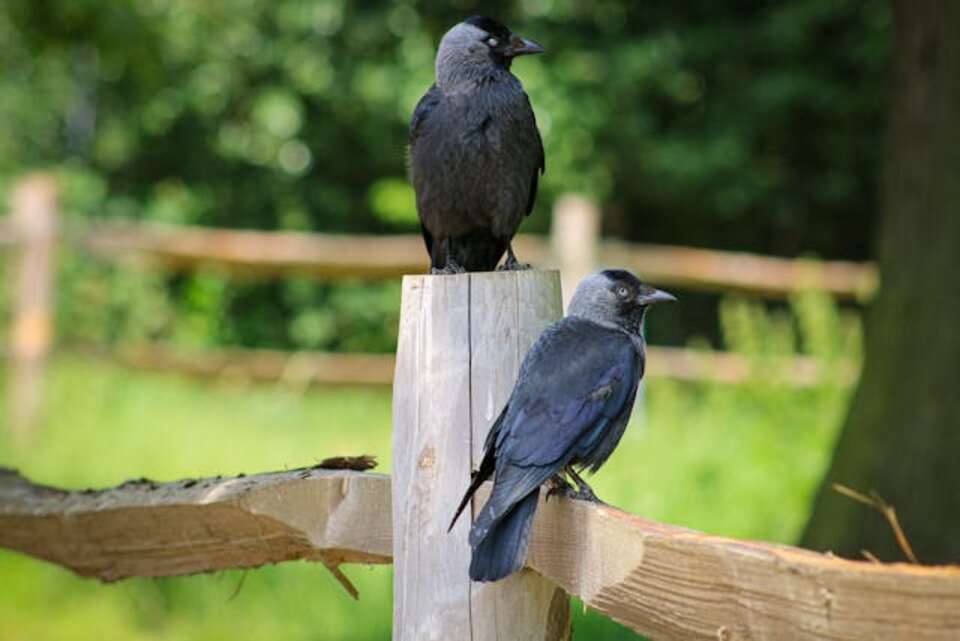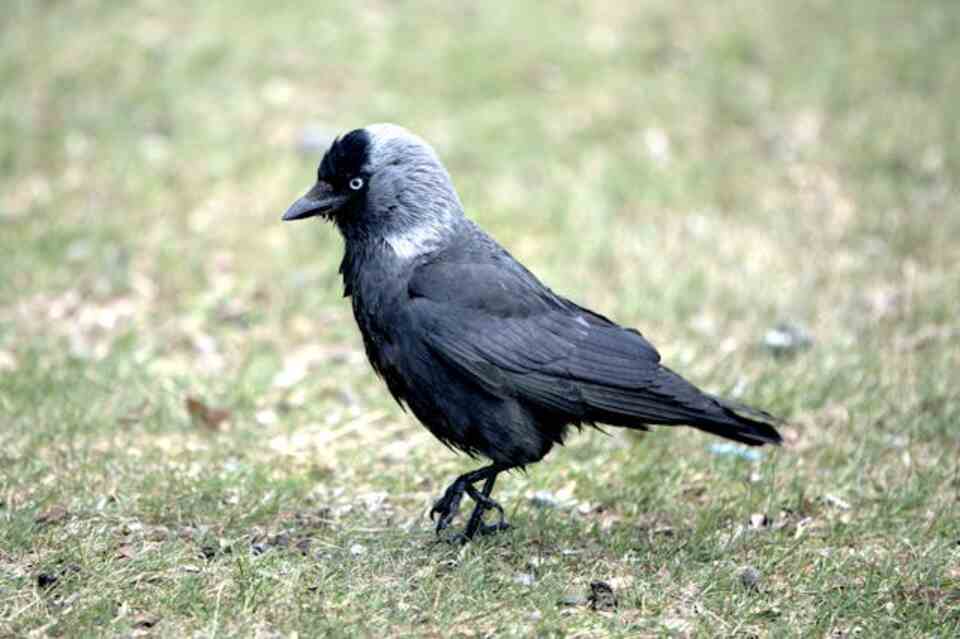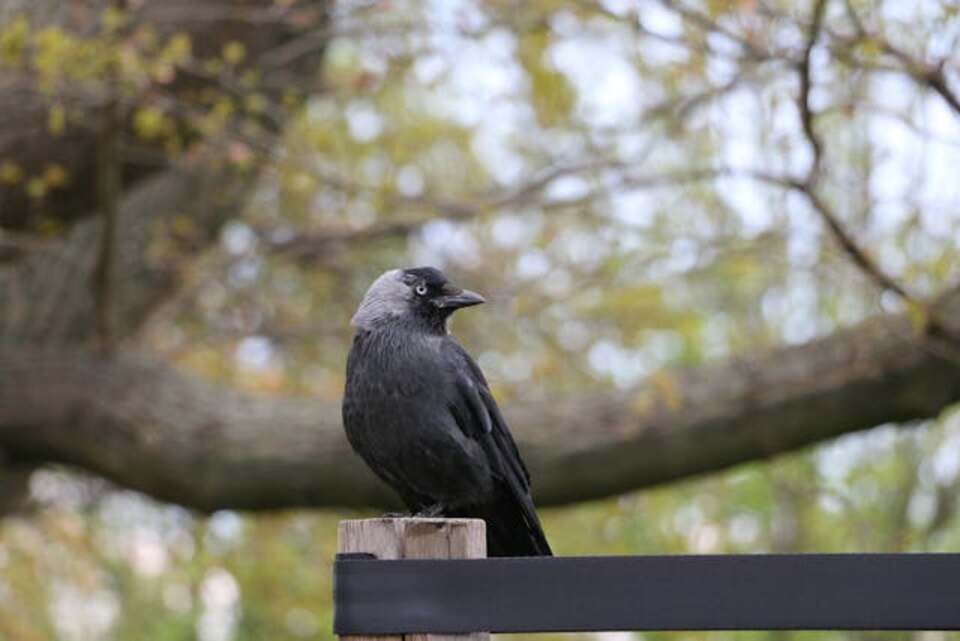Jackdaws, with their striking silver-gray napes and piercing pale eyes, are among the most charismatic members of the corvid family. These intelligent and social birds can make delightful visitors to your garden, bringing life, activity, and a touch of wild nature to your outdoor space.
If you’re interested in attracting these fascinating creatures to your garden, you’ve come to the right place. This comprehensive guide will walk you through everything you need to know about creating a jackdaw-friendly environment, from understanding their behavior to providing the right food and habitat.
Table of Contents
Understanding Jackdaws: The Key to Attraction
The Jackdaw’s Profile
Jackdaws (Corvus monedula) are small, highly intelligent members of the crow family. They are widespread across Europe, western Asia, and North Africa, adapting well to various habitats, including urban and suburban areas. These birds are known for their distinctive appearance:
- Size: Smaller than crows, typically 34-39 cm in length
- Plumage: Mostly black with a characteristic silver-gray nape
- Eyes: Pale, almost white irises that stand out against their dark feathers
- Bill: Short, black bill compared to other corvids
Understanding these physical characteristics will help you identify jackdaws when they start visiting your garden.
Here is a table comparing the Western Jackdaw and the Daurian Jackdaw:
| Feature | Western Jackdaw (Coloeus monedula) | Daurian Jackdaw (Coloeus dauuricus) |
|---|---|---|
| Breeding Range | Europe, northern Asia, Northern Africa | China, eastern Siberia, Japan |
| Size | Larger | Smaller |
| Plumage Color | Pale grey areas | Almost white areas |
| Iris Color | Pale | Dark |
| Shape, Calls, Behavior | Very similar | Very similar |
| Interbreeding | Do not interbreed where ranges meet in Mongolia | Do not interbreed where ranges meet in Mongolia |
This table provides a clear comparison of the key characteristics and differences between the Western Jackdaw and the Daurian Jackdaw.
Jackdaw Behavior and Social Structure
To effectively attract jackdaws, it’s crucial to understand their behavior and social structure. Here are some key points:
- Social Nature: Jackdaws are highly social birds, often seen in pairs or small groups.
- Monogamous Partnerships: They form strong, lifelong pair bonds.
- Communal Roosting: Large flocks gather to roost together, especially in winter.
- Intelligent Problem-Solvers: Like other corvids, jackdaws are known for their problem-solving abilities and tool use.
- Vocal Communication: They have a variety of calls, including a distinctive “chyak-chyak” sound.
- Adaptable Feeders: Jackdaws are omnivorous and opportunistic, eating a wide variety of foods.
By keeping these behavioral traits in mind, you can create an environment that caters to their natural instincts and preferences.
Creating a Jackdaw-Friendly Garden
Landscaping for Jackdaws
The first step in attracting jackdaws to your garden is to create an environment that meets their needs. Here are some landscaping tips to make your garden more appealing to these birds:
1. Provide Perches and Lookout Points
Jackdaws love to survey their surroundings. Include tall trees or structures in your garden that can serve as perches. Some good options include:
- Mature deciduous trees (oak, beech, ash)
- Tall conifers
- Sturdy garden poles or posts
2. Create Open Areas
While jackdaws appreciate high perches, they also need open areas for foraging. Maintain some open lawn space or create graveled areas where jackdaws can search for insects and other food items.
3. Include Water Features
Like all birds, jackdaws need access to fresh water for drinking and bathing. Consider adding:
- A shallow bird bath
- A small pond with gently sloping edges
- A trickling fountain or water feature
Ensure that any water sources are kept clean and fresh to prevent the spread of diseases.
4. Plant Native Species
Incorporating native plants in your garden can attract insects and produce berries or seeds that jackdaws enjoy. Some plants to consider include:
- Rowan trees (Sorbus aucuparia)
- Hawthorn (Crataegus monogyna)
- Elder (Sambucus nigra)
- Wild cherry (Prunus avium)
These plants not only provide food but also create a more natural habitat that jackdaws will find appealing.
Providing Nesting Sites
Jackdaws are cavity nesters, typically choosing holes in trees, buildings, or cliffs. To encourage them to nest in your garden, you can:
- Preserve Natural Cavities: If you have old trees with natural cavities, preserve them when safe to do so.
- Install Nest Boxes: Place specially designed jackdaw nest boxes high up on trees or buildings. The ideal specifications for a jackdaw nest box are:
- Entrance hole: 75mm diameter
- Internal floor area: At least 20cm x 20cm
- Internal height: At least 30cm
- Position: 3-5 meters high, with a clear flight path
- Create Clusters: Jackdaws often nest in loose colonies, so consider installing multiple nest boxes in close proximity.
- Provide Nesting Material: Leave out natural materials like small twigs, moss, and animal hair for jackdaws to use in nest building.
Remember that jackdaws may take time to accept artificial nest sites, so be patient and consistent in your efforts.
Feeding Jackdaws: The Right Diet for Attraction
Understanding Jackdaw Diet
Jackdaws are omnivorous birds with a varied diet. In the wild, they consume:
- Insects and other invertebrates
- Small vertebrates (occasionally)
- Seeds and grains
- Fruits and berries
- Nuts
- Carrion (in small amounts)
By offering a variety of these food types, you can make your garden an attractive feeding ground for jackdaws.
Best Foods to Offer Jackdaws
To attract jackdaws to your garden, consider offering the following foods:
- Seeds and Grains:
- Fruits and Berries:
- Apples (cut into small pieces)
- Grapes
- Raisins (in moderation)
- Blueberries
- Protein Sources:
- Mealworms (live or dried)
- Suet cakes or balls (especially those containing insects)
- Small pieces of cheese (in moderation)
- Kitchen Scraps (in moderation):
- Cooked pasta or rice
- Bread crumbs
- Unsalted bacon rind
Feeding Methods and Tips
How you present the food can be just as important as what you offer. Here are some tips for effective jackdaw feeding:
- Use Appropriate Feeders:
- Platform feeders or ground feeding trays
- Sturdy hanging feeders that can support multiple birds
- Suet cage feeders
- Scatter Feeding: Jackdaws naturally forage on the ground. Scatter some food on open areas of your lawn or on a patio to mimic this behavior.
- Consistent Feeding: Once you start feeding, try to be consistent. Jackdaws may come to rely on your garden as a food source.
- Vary Food Offerings: Provide a mix of different foods to cater to jackdaws’ diverse diet and to attract them throughout the year.
- Fresh Water: Always provide fresh, clean water near feeding areas.
- Cleanliness: Regularly clean feeders and feeding areas to prevent the spread of diseases.
Remember, while feeding can be an effective way to attract jackdaws, it’s important to do so responsibly and in a way that doesn’t create dependency or disrupt their natural foraging behaviors.

Creating a Safe Environment for Jackdaws
Minimizing Threats and Hazards
To ensure that jackdaws feel safe and continue to visit your garden, it’s important to minimize potential threats and hazards. Here are some steps you can take:
1. Reduce Predator Access
While adult jackdaws have few natural predators, they can be vulnerable to certain threats, especially during nesting season. To protect them:
- Keep domestic cats indoors, especially during dawn and dusk when birds are most active.
- Avoid using pesticides that might harm birds or reduce their food sources.
- If you have bird feeders, position them away from areas where predators might hide.
2. Window Safety
Birds, including jackdaws, can sometimes collide with windows. To prevent this:
- Apply window decals or hang strings of beads in front of large windows.
- Position feeders and bird baths either very close to windows (less than 1 meter) or far away (more than 10 meters) to reduce the risk of high-speed collisions.
3. Safe Nesting Sites
Ensure that any nest boxes or natural cavities you’re encouraging jackdaws to use are:
- Secure and not prone to falling or being blown down in strong winds.
- Protected from direct sunlight and prevailing winds.
- Inaccessible to potential predators like squirrels or larger birds.
4. Avoid Harmful Materials
Be mindful of materials used in your garden that could be harmful to jackdaws:
- Don’t use netting or mesh with large holes that birds could become entangled in.
- Avoid using glue traps for pest control, as these can catch and harm birds.
- Be cautious with string or twine in the garden, as birds can become tangled in these.
Coexisting with Jackdaws
While jackdaws can be delightful garden visitors, it’s important to maintain a balance that allows for peaceful coexistence. Here are some tips:
- Manage Noise Levels: Jackdaws can be vocal, especially in groups. If noise becomes an issue, consider limiting feeding to certain times of day.
- Prevent Overfeeding: While it’s great to provide food, overfeeding can lead to an unnaturally large population of jackdaws in your area. Feed in moderation.
- Respect Neighbors: Be considerate of neighbors who may not share your enthusiasm for jackdaws. Try to position feeding and nesting sites away from property boundaries.
- Educate Others: Share your knowledge about the benefits of jackdaws (such as pest control) with neighbors and local community members to foster a positive attitude towards these birds.
Observing and Enjoying Jackdaws
Setting Up Observation Points
Once you’ve successfully attracted jackdaws to your garden, you’ll want to observe and enjoy their presence. Here are some tips for setting up good observation points:
- Indoor Viewing: Set up a comfortable seat near a window overlooking your garden. Use binoculars for a closer view without disturbing the birds.
- Outdoor Blinds: Consider setting up a small, camouflaged blind in your garden for closer observation.
- Photography: If you’re interested in photographing jackdaws, use a long lens to capture images from a distance without disturbing the birds.
- Journaling: Keep a nature journal to record jackdaw behaviors, feeding patterns, and any interesting observations.
Understanding Jackdaw Behavior
As you observe jackdaws in your garden, you’ll start to notice interesting behaviors. Here are some things to look out for:
- Pair Bonding: Watch for pairs of jackdaws grooming each other or sharing food, signs of their strong pair bonds.
- Social Interactions: Observe how jackdaws interact with each other and with other bird species in your garden.
- Problem-Solving: You might see jackdaws using creative methods to access food or materials, showcasing their intelligence.
- Seasonal Changes: Notice how jackdaw behavior changes throughout the year, from nest-building in spring to flocking in winter.
Citizen Science Opportunities
Your observations of jackdaws can contribute to scientific knowledge. Consider participating in citizen science projects such as:
- Bird counting programs run by local ornithological societies
- Online platforms like eBird for recording bird sightings
- Specific corvid research projects that may be running in your area
By sharing your observations, you can help researchers better understand jackdaw populations and behaviors.
Troubleshooting Common Issues
Jackdaws Not Visiting
If you’ve set up your garden for jackdaws but they’re not visiting, consider these potential issues:
- Lack of Food: Ensure you’re offering appropriate foods in sufficient quantities.
- Inadequate Habitat: Check if your garden provides the necessary elements like perches, open areas, and water sources.
- Predator Presence: Look for signs of predators that might be deterring jackdaws.
- Competition: Other bird species might be monopolizing the resources you’ve provided.
- Patience Required: Remember that it can take time for jackdaws to discover and trust a new feeding site.
Managing Jackdaw Numbers
While attracting jackdaws is the goal, sometimes you might find you have more visitors than you bargained for. If jackdaw numbers become problematic:
- Reduce Food Quantity: Offer less food to discourage large flocks from forming.
- Change Feeding Times: Vary when you put food out to prevent jackdaws from becoming too reliant on your garden.
- Diversify Food Sources: Spread food across multiple locations to prevent crowding.
- Remove Nesting Sites: If you have too many nesting jackdaws, consider temporarily blocking access to some nesting boxes.
Conclusion: The Rewards of Attracting Jackdaws
Attracting jackdaws to your garden can be a rewarding experience that brings you closer to nature. These intelligent, social birds offer endless opportunities for observation and learning. By creating a jackdaw-friendly environment, you’re not only enriching your own life but also providing valuable resources for a species that has adapted to live alongside humans.
Remember that attracting wildlife is a process that requires patience and consistency. It may take time for jackdaws to discover and trust your garden as a reliable source of food and shelter. But with persistence and the right approach, you’ll soon find yourself enjoying the company of these charming corvids.
As you embark on your journey to attract jackdaws, keep in mind the importance of responsible wildlife gardening. Always prioritize the birds’ well-being and natural behaviors over your desire to attract them. By striking this balance, you can create a harmonious environment that benefits both you and the jackdaws.
So, set up those feeders, plant those native species, and keep your eyes peeled for the flash of silver-gray napes and those distinctive pale eyes. Before you know it, your garden could become a bustling hub of jackdaw activity, providing you with years of fascination and joy.





